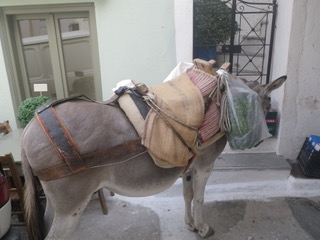37:40.129N 24:19.242E

Muskrat
Chris and Alison
Thu 25 Aug 2022 12:11
19/08/22 Left Kythnos and had to motor all the way to Kea (O Nikolaou) the wind had completely gone, leaving a glassy sea. Tried to find a spot in Ormos Vourkari but there wasn’t any room and it was either too shallow or too deep, so we went into Coal Bunker bay that was almost empty. Swinging to anchor in a lovely secluded bay watching the coming and going of the many yachts that try to crowd into the town quay. This is obviously a stop over for the charter yachts as they either leave their marina at the beginning of their charter, or it is a stopover on their way back at the end of the week. After having antiquity fatigue in Turkey, we were now having antiquity withdrawal symptoms, so it was with great excitement that we found some ruins on Kea. They are only open at the weekends but we planned to stay until then anyway, so we made a note of the opening times and planned to go back at the weekend. The chora (Ioulis) on Kea is only 4 miles from the anchorage, uphill, but in the heat of the day (35’C +), we felt it was too far to walk, so the next step was to decipher the bus time table. In the end we decided that the bus must do a loop (that varied depending on what day of the week it was) and the times on the table were when the bus left that particular area, you had to guess when it would arrive at your stop! We did eventually managed to get the bus the next day that took us straight to the chora with no other stops, other than one at the garage to get some petrol! Ioulis is all white washed buildings with either blue painted roofs or red tiled roofs with very narrow streets. Cars and buses have to stop outside the town, no traffic is allowed into the narrow streets, some motor bikes obviously do though. About 20 minutes walk to the west of the town is a rock carving of a lion, known locally as the “pussy cat” believed to have been carved round about 600BC. In ancient times the four cities of Keos included loulis, Karthala, Koressos and Poleessa, they were established in Archaic times (7th-6' c.B.C.). All but Poleessa issued their own silver coinage. With the exception of loulis, in the interior of the island, the cities were coastal with their own harbours. They all had fortification walls, while towers in various strategic places throughout the island played a part In the control and protection of each city. A web of roads connected the cities to each other and the individual city Itself with its own dependent areas.  The narrow streets in the Chora  Kea Chora  The carved Lion 600BC  The shopping trolley, Kea style 21/08/22 We visited the Agia Irini ancient site in the morning. Unfortunately there were no information boards to tell us what we were looking at but there was an informative guide who could just about speak enough English to give us an idea of what we were looking at. Most of the information we needed we would have got from the archeological museum in the Chora, had we known this yesterday we would have visited it, so another visit up the mountain was needed to get the information on the site. In the mean time some information was picked up from the internet:- The ancient site of Agia Irini is an ancient seaside settlement that dates back to the late Neolithic Age (3,300BC). The settlement give indications that the Cycladic culture of the early Bronze Age existed in they area during the period. The town acted as a communication channel between the Minoan and the Mycenaean culture. The notable architectural constructions of this area included a temple and the mansion of the master. The most important buildings existed in this site were constructed during the period 1,600 - 1,400BC. Excavations around this area revealed many notable art objects and pottery items. Among other items of pottery were the “Kores”, statues of girls with long clothes made of clay. These artefacts are today displayed at the archaeological museum of Ioulida (the Chora we visited yesterday). The town’s harbour is now under the sea due to the Mediterranean rise in sea level, but the remains of the harbour and an old sunken ship can still be seen at the bay close to the site. www.greeka.com accessed 21/08/22  Ancient site of Agia Irini Kea (sorry about the dirty lens)  |